Sound Bites - Issue #35 - July 2016

Issue #35 July | 2016
Community Education's Premiere Online Magazine
On the Cover
Carmelo Fiannaca. Life, Piece by Piece
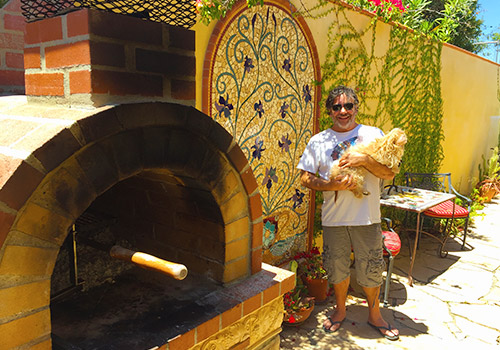 Carmelo Fiannaca's outdoor oven, next to one of his mosaic art pieces, shows his love of cooking
Carmelo Fiannaca's outdoor oven, next to one of his mosaic art pieces, shows his love of cooking
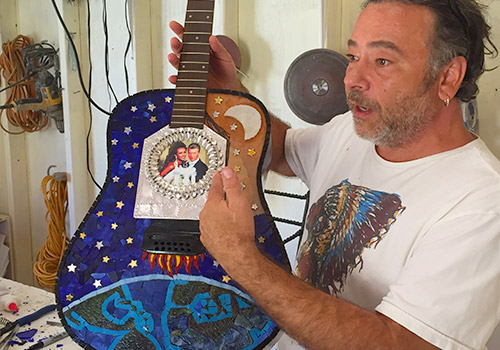 Inspired by one of his students who created a mosaic violin, Carmelo works on a David Bowie guitar
Inspired by one of his students who created a mosaic violin, Carmelo works on a David Bowie guitar
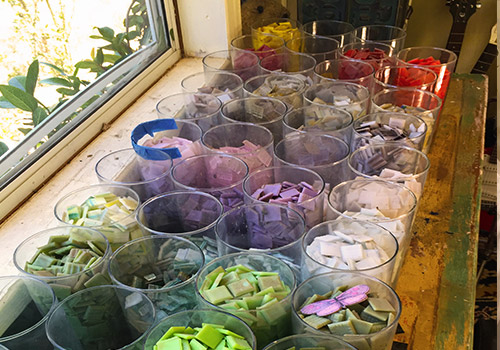 Tiles in Carmelo Fiannaca's workshop
Tiles in Carmelo Fiannaca's workshop
[Part 1 of 2] The best way to tell the story of Community Ed mosaic art instructor Carmelo Fiannaca is to visit him in his stunning Tuscan-style villa with its sweeping view of the Malibu coastline.
It's there you will see the beautiful mosaic work that this award-winning and internationally exhibited artist has done throughout the house, both indoors and outdoors and in his workshop.
It's there you will see his outdoor pizza oven, a clue to his love for cooking for others.
View images of Carmelo Fiannaca's work
What the house will not fully reveal is his range of artistic talents, or the impressive commissions he has received (including John Wayne's former estate), or the journey that led him from Sicily to California via Switzerland, or how Santa Monica College changed his life, or how much he loves teaching students who all have interesting stories of their own.
Fiannaca's deep passion for art began as a young child in Agrigento Sicily, Italy. His family moved to Switzerland when he was young, and it was during this time that he discovered drawing and painting.
By 10 years old, he gained attention through his comics and stories, whose illustrations showed advanced abilities in art. During a summer trip to Sicily, Carmelo discovered the Cathedral of Monreale in Palermo where he became inspired to explore the color, texture and surfaces of mosaic art.
He received his degree from Plattenleger Verband in Lucerne, Switzerland in design, restoration, fabrication and installation. Carmelo continued his studies through a scholarship from the National Art Association and later ended up at SMC, where he received his degree from the School of Design, Art and Architecture.
The path that led Fiannaca to SMC's art school was actually a musical one. A guitarist, he came to Los Angeles in 1993 to study at the Musicians Institute in Hollywood. Afterwards, he started playing in clubs and bars in Hollywood with a band called Big Muckamuck, whose lead signer was Tequila, a well-known vocalist.
"That's what kept me here," he said. "I remember thinking, 'This is fun.' But on the side, I was making mosaic tables."
Eventually, he moved back to Europe, sold his house in Sicily and returned to L.A. to study sculpture and art at SMC.
"I loved the Art Department," he said. "So many wonderful professors took me under their wing because they knew how dedicated I was. The school was like my studio, and I would often arrive before classes started and leave after the last professor left."
Fiannaca cites two professors' sculpture professor Don Hartmann and Ronn Davis, currently Art Department chair - as particularly influential in his artistic pursuits and career. In fact, Davis, who is still a close friend, was the one who suggested Fiannaca to teach at SMC Community Ed, which he started doing five years ago.
Fiannaca not only took classes through the Art Department, but he was also admitted to SMC's School of Design, Art and Architecture, a widely praised program for a small group of talented students who were taught by leading artists such as George Herms.
Right after graduating from SMC, Fiannaca got a significant commission to do a mural in a wealthy couple's home in Montana. It took him a year to complete the mural in his studio before shipping it to his client.
That launched his career as an artist who designs, fabricates and installs one-of-a-kind mosaics and sculptures for gallery, architectural, community and home settings. He says his mosaics are produced using the finest materials gathered from sources around the world: smalti, gold, marble, vitreous glass, ceramic and more.
He recently completed a three-year-long installation at Duke's Point - the former home of John Wayne - in Newport Beach. His award-winning art is exhibited both nationally and internationally and is represented in private, public and corporate collections.
An accomplished artist, he travels the world and is constantly exploring both classical and cutting-edge mosaics, sculptures and installations. He continues to draw his inspiration from the world around him, and his work reflects many of the masters: Picasso, Gaudi, Warhol, Klimt, Hundertwasse, Nikki de Saint Phalle, Simon Rodia (creator of the Watts Towers), as well as his own Italian mosaic art heritage.
Carmelo Fiannaca will teach Introduction to Mosaic Art beginning Sept. 10, Mosaic Art II beginning Sept. 10, and Mosaic Art II beginning Oct. 15.
(Next month in Part 2: The fire that destroyed some of Fiannaca's work, his love of teaching, and more.)

What's New
Art as Ephemeral as Time
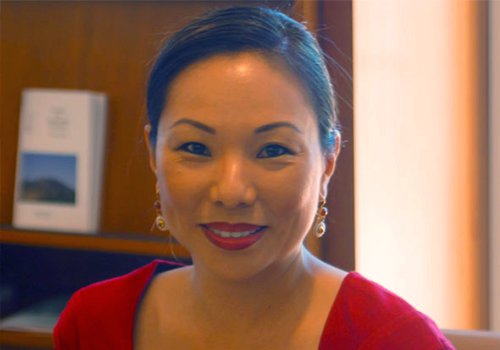
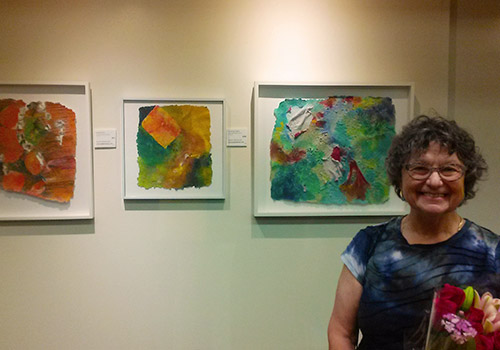 Arlene Weinstock's work can be seen at the Women Painters West exhibit/Encino
Arlene Weinstock's work can be seen at the Women Painters West exhibit/Encino
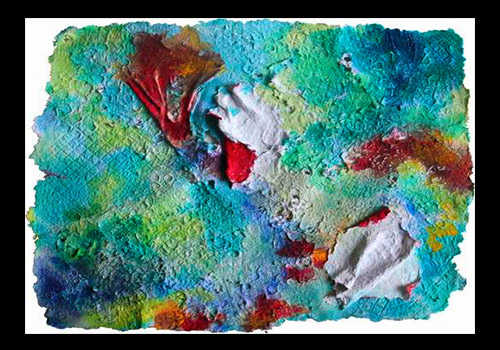 Arlene Weinstock's "Oceanmind" is one of her pieces in the Women Painters West exhibit
Arlene Weinstock's "Oceanmind" is one of her pieces in the Women Painters West exhibit
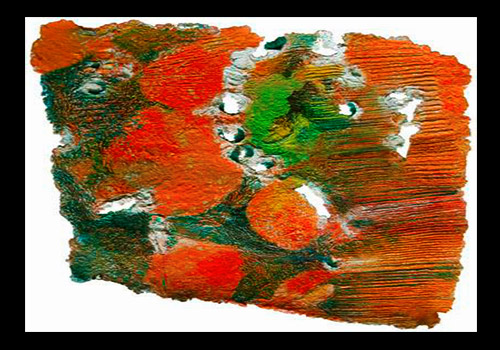 "Impacture" by Arlene Weinstock is also in the art show
"Impacture" by Arlene Weinstock is also in the art show
from the desk of Alice Meyering
The main hall of the building is decidedly cooler than the hot San Fernando Valley afternoon outside. In the midst of the buzz generated by the crowd in the hallway, I recognize the petite woman with the wiry silvery hair. As we lock eyes, she greets me with a broad and bright smile. Clearly, Arlene Weinstock is in her element: a small and intimate reception for the Women Painters West group exhibit in Encino, surrounded by art lovers and fellow artists like herself.
As she walks me down the spacious hallway where sparkling glass display cases flanking it are filled with different artworks from her compadres, Arlene is eager to show me the three pieces of her work that were juried into the exhibition, but they are not the usual colored pencil fares that Arlene teaches in class at SMC Community Ed. Instead, they are one-of-a-kind paper art that fulfilled a desire that Arlene had for a long time.
As Arlene tells it, she had long wanted to make paper art. Each of her works is the reincarnation of used office papers, broken down and reshaped by hands, defined almost solely by its tactility so strong is its visual effect on the viewers. One can say it is much like sculpting with paper mush - each piece claiming its new life by interacting with the hands that work it, slowly unveiling what story that needs to be told, while words and images of its previous life remained hidden from view.
These pieces are as individualistic as they are thought-provoking; I admit I haven't had this much fun with art since teaching my 3-year-old son years ago how to appreciate the Aphrodite statue at the Getty Center.
Digging a little more into her motivation to create this unusual type of art, Arlene's artistic ideology is as timely as it is humbling. Not only does her art incorporate and practice recycling (or upcycling), but it is actually the artist's intention that each piece will eventually deteriorate with the passage of time.
Non-toxic watercolors are used to minimize the final impact to the environment, but immortality isn't what the artist is after. Like a living creature, her art work will have a definite life span beyond which it will fade and disintegrate. It will collect dust as time goes by and it may disappear into the earth, or some other clever hands may shape and recycle it yet again into something 'other,' but it won't stay the same - not like the Mona Lisa, frozen in her forever enigmatic smile, gawked by countless tourists behind velvet ropes, reduced to a backdrop to selfies.
In other words, Arlene's paper art is touchable to every man and woman: it is there to inspire and be inspired, it is transforming as it is transformed, and it is as ephemeral as life itself.
As I bid her goodbye, we talked about the joy of our work. Her, the fulfillment to finally give birth to the work that has cried out to be created for so long, and me, for moments like this when I realized how blessed I am to be invited to walk into someone's life and get to know them.
(Arlene Weinstock's work can be seen at the Women Painters West exhibit in Encino through July 23.)
Follow us on Facebook, Twitter and other social media outlets for our latest news.

In Depth:
Through the Lens of a Commitment
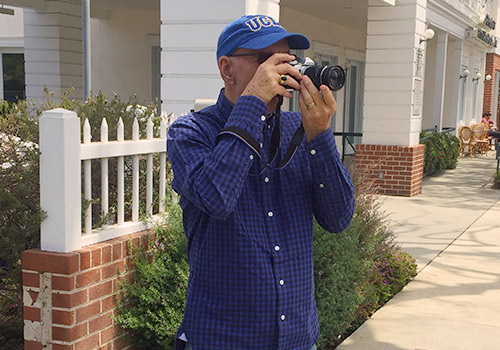 Frank Damon is a prolific photographer who takes at least one picture every day
Frank Damon is a prolific photographer who takes at least one picture every day
 "Cityscape" by Frank Damon
"Cityscape" by Frank Damon
 Sunflower(calendar) by Frank Damon
Sunflower(calendar) by Frank Damon
Frank Damon not only believes in quality when it comes to photography, but quantity as well.
The retired Pacific Palisades attorney - and winner of the 2016 Community Ed Student Photo Contest - has snapped at least one shot a day every day since Jan. 1, 2010. He's participated in the 365 Project - joining 160,000 people around the world who create an image a day for 365 days - with relish.
Browse a collection of Frank Damon's Photographs
"Through surgery, illnesses, funerals and more I've stuck with the 365 Project," Damon says. "I really like shooting every day, and it has stretched my ability to see things and look for things. It really is fun, it gives me a chance to try out new software, and it forces me to learn more."
Sometimes the photos are as simple as flowers in his garden or food on his table. Other times, they are stunning images like the one he took of the Santa Monica Pier that won him the Community Ed contest. (Damon captured that image with a Canon 5D Mark 3 camera with a wide-angle lens.)
Damon has been taking pictures since he was a child, but had to put down his camera for a long stretch of time when his law practice became too busy. Eventually, as his workload began to lessen as he moved toward semi-retirement and then full retirement, he switched from film to digital, purchased Adobe Photoshop and embarked on a journey armed with new photo technology.
"I'd played around in the darkroom, but I've always been interested in new technology, and when I started learning Photoshop, it was fascinating and created a great challenge," he says.
Damon says he loves learning, and several years ago enrolled in academic courses at SMC, including Spanish, photography and web design. Then he took Ed Mangus' "On the Street with Your Camera" class at Community Ed two years ago.
"I like landscapes but I really wanted to learn something new," he says. "I've used techniques that I learned in Ed Mangus' class."
Of course, Damon does not live by photography alone. He and his wife Linda of 45 years are active in their nine godchildren's lives. And Damon has been a volunteer with many professional and nonprofit organizations over the past few decades. Currently, he is a docent at the Getty Center and volunteers with the UCLA Academic Advancement Program, PrimeTime Los Angeles Unified School District's program assisting with photographic and essay writing projects, and with the UCLA Longevity Center as a Certified Memory Trainer.
He and his wife are also avid worldwide travelers. Over a 34-year period, he visited (and photographed) every state capital and each of their Capitol buildings, as well as seven Presidential Libraries (with more to come).
Damon believes that photography is often storytelling. "Sometimes you really do want to tell a story but sometimes it's something that grabs you and that might be a story in and of itself," he says.
He adds, "There's always something to see. The world is a fascinating place."
Which photographers do you admire?
Ansel Adams, Walker Evans, Robert Mapplethorpe, Edward Weston and Annie Leibovitz.
Tell us one to three things that most people don't know about you.
I speak Spanish. I have nine godchildren and 12 "god-grandchildren" (two of whom refer to me and my wife as grandpa and grandma). I hated high school.
What is your idea of a perfect day?
Exercising, going to the Getty Center, having lunch with friends, taking some photos for a while, reading and answering emails, reading the paper and news online, spending some time with Photoshop, having dinner with my wife and watching one of our TV programs.
What book(s) are on your nightstand now?
"The Last Mile" by David Baldacci, "Lady Bird and Lyndon" by Betty Boyd Caroli, "Just Kids" by Patti Smith, and "And Then All Hell Broke Loose" by Richard Engel.

Viewpoint
New Healthcare Training Programs Coming Soon!
 Michelle King, Director Career & Contract Ed.
Michelle King, Director Career & Contract Ed.


I'm excited to announce we will be offering two new healthcare-related, not-for-credit career training programs beginning January 2017 - Home Healthcare Aide and Medical Administrative Assistant.
The Home Healthcare Aide career-training program is an 8-week evening classroom-based course, and the Medical Administrative Assistant program is an online, self-directed, self-paced course that can be completed in as few as eight weeks. Both programs providestudents the opportunity to obtain nationally recognized certification.
The courses will be available to anyone seeking in-demand job skills, including individuals seeking job training who are being referred by a One-Stop, American Job Center and/or a WorkSource Center. These courses will be included on SMC's list of approved courses included on the state Employment Development Department's ETPL (Eligible Training Provider List).
For more information on these courses or other professional development training opportunities, please go to http://commed.smc.edu or call (310) 434-3400 or email commed@smc.edu.
Warm regards,
Michelle King
Director of Career &
Contract Education

 Donate Today!
Donate Today!
